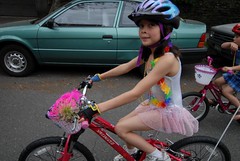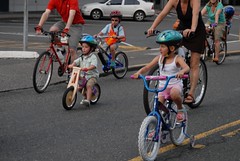
[Publisher’s note: This article is by our Family Biking columnist Marion Rice. Marion’s last two columns have been about biking while pregnant. Today she talks about negotiating a first bike purchase with your child.]
Starting at about 10 years old, I can remember going everywhere on my bike with my group of friends on the weekend. We would pack lunches and take off for points unknown. Of course we would have to bring a dime or two to call home and check in with our parents during the day. Sometimes we would call to beg for a ride home after having biked a good 20 miles away.
Joining the family cycling pack or being able to go out on your bike with friends is definitely a rite of passage. There are many ways that bikes find children to ride them. If you are thinking about purchasing a new bike for your child this article is geared to help you navigate that process so your child gets the right bike and everyone has a good time.
There are so many things for parents to consider when purchasing a road worthy bike, safety, quality, price etc. The first road bike you get for your child ought to be something he or she will have for a few years and something sturdy and reliable enough to get them where they need to go safely, with or without you.
The way I see it, there are three components to buying a child a bike: the things that the parent cares about, the things the child cares about, and the way parent and child negotiate the purchase together.
The Things The Parent Cares About
As parents we care primarily about safety and quality. We want our child to have a bike that provides them a sturdy and safe ride and allows them to keep up with us at a moderate pace.
The main thing is to avoid saddling your child with too much, too soon. We don’t want the bike to be too big or too small. Too many gears might not work for a young, inexperienced rider. Coaster (foot) brakes are easier than hand brakes for many kids.
Some bikes come with the ability to adjust the pedal radius to accommodate changes in the riders’ leg length. This is a nice feature if you want the bike to grow with your child.
Definitely make sure to get a good bike bell and front and rear light. You may also want to purchase fenders that fit the model you are buying so your child isn’t soaked after a ride in the rain.
It’s true; you get what you pay for. If you want your child’s bike to last more than a year, don’t buy a bike from a big box store. Spend the money and get something dependable that will last and still have some resale value or can be handed down.
The Things The Child Cares About
The things that matter most to our kids may not be at the top of our list, though we still care about them. For instance, I would not choose a bike in a color I didn’t love, and neither will your child. Be prepared to have this matter.
Before you go to the bike shop, sit down together and make a list of things each of you thinks the bike needs to have.
Kids don’t want a bike that doesn’t fit right and is scary to ride. There is a balance between getting a bike that fits them now and a bike that still has room to grow. If the bike is too small, you’ll be shopping for a new one before you know it. If the bike is too big your child may feel uncomfortable on it and have trouble controlling it, which will not inspire the best riding experience for either of you.
Accessories are a great way to individualize and customize a bike. There are so many cool things out there for kids — bike bells, horns, streamers, spoke cards, baskets, and fancy helmets. All of these things can help a child express their own personality through their bike and make it uniquely their own.
Negotiating the Purchase Together
Some parents surprise their child with a bike and avoid this issue altogether. I think for children five and over, negotiating the purchase is a good learning opportunity and important part of getting a bike they will love, want to ride, and will take care of.
As the parent you are in control of the process and manage the decision, but that doesn’t mean that you decide which bike to buy; it means your job is to help your child decide which bike to buy. Some strategy and preparation can help make this joint decision go smoothly.
Do some investigating on your own beforehand. Find a couple of bike shops that you feel has choices you would be satisfied with. If you take your child into a store and you don’t know the selection, chances are they will find the one bike you absolutely don’t want them to get.
Get your child involved in the purchase. Before you go to the bike shop, sit down together and make a list of things each of you thinks the bike needs to have. Then star the items that are must-haves. At the bottom of the list make sure to write down a couple of things the child has complete control over, like deciding which bike bell to buy. Take this list to the store with you and use it to guide your discussion and ultimate buying decision.
Timing is important. Shopping with kids can be challenging even when kids are excited and looking forward to it. Make sure to start out when they are rested and fed. They won’t realistically be able to be part of a negotiation if they are tired, hungry or would rather be doing something else.
Negotiating isn’t about winning or losing or reluctantly giving in — it’s about getting to a place where both parties agree. If you feel like the process isn’t going well its okay to take a break and come at it again another day.
Once you have the bike at home, plan the maiden voyage together. Perhaps a fun short excursion to an ice cream store would be in order to celebrate. Your child can get used to how the bike feels and you can make any adjustments that need to be made for a smooth ride.
— Read more of Marion Rice’s articles here.




